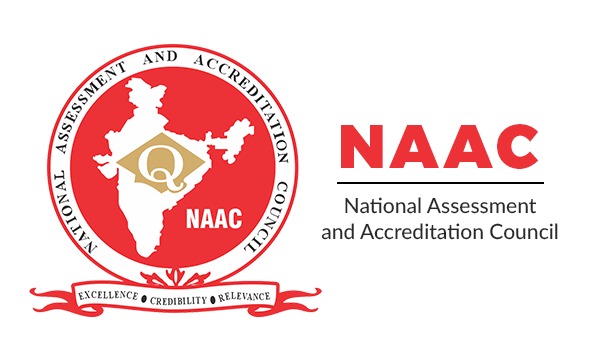
The National Assessment and Accreditation Council (NAAC), established in 1994 as an autonomous institution of the University Grants Commission (UGC), is headquartered at Bengaluru. The vision of the NAAC is to ensure that quality assurance is an integral part of the functioning of Higher Education Institutions (HEIs).
The NAAC functions through its General Council (GC) and Executive Committee (EC). The councils comprise educational administrators, policy makers and senior academicians of Indian higher education system. The UGC Chairperson is the President of the GC, an eminent academician nominated by the President of GC (NAAC) as the Chairperson of the EC. The Director is the academic and administrative head of NAAC and is also the member-secretary of both the GC and the EC. In addition to the statutory bodies that steer its policies and core staff to support its activities, NAAC is directed by the advisory and consultative committees constituted from time to time.
The methodology employed by NAAC for Assessment and Accreditation is indistinguishable from those methods followed by Quality Assurance (QA) agencies across the world and consists of self-assessment by the institution along with external peer assessment organized by NAAC.
Core Values
In order to ensure external and internal validity and credibility, the QA process of NAAC is grounded within a value framework which is suitable and appropriate to the National context.
The accreditation framework of NAAC is thus based on five core values detailed below:
- Contributing to National Development
- Fostering Global Competencies among Students
- Inculcating a Value System among Students
- Promoting the Use of Technology
- Quest for Excellence
The five core values form the foundation for assessment of institutions aiming for accreditation by NAAC. The HEIs may also add their own core values to these in conformity with the goals behind the introduction of the NAAC.
ASSESSMENT AND ACCREDITATION OF HIGHER EDUCATION INSTITUTIONS
The A&A process of NAAC is an exercise being carried out by the NAAC along with the HEI being assessed. Over the years, the feedback procured from the HEIs, other stakeholders and the developments in the national scene, appropriate revisions have been made so as to accelerate the process with greater quality rigor.
QUALITY INDICATOR FRAMEWORK (QIF)
The criteria-based assessment forms the backbone of A&A process of NAAC. The seven criteria represent the core functions and activities of a HEI. In the framework not only the academic and administrative aspects of institutional functioning but also the emerging issues have been included.
The seven Criteria to serve as basis for assessment of HEIs are:
Up
- Curricular Aspects
- Teaching-Learning and Evaluation
- Research, Innovations and Extension
- Infrastructure and Learning Resources
- Student Support and Progression
- Governance, Leadership and Management
- Institutional Values and Best Practices
Under each Criterion, a few Key Indicators are identified. These Key Indicators (KIs) are further delineated as Metrics which actually elicit responses from the HEIs. Higher Education Institutions (HEIs) are categorized into three types i.e., University, Autonomous College, and Affiliated/Constituent College for the Assessment and Accreditation (A&A). Figure 1: Seven-Criterias-for-NAAC-accreditation-with-marks-arranged-in-ascending-order for affiliated colleges

THE ASSESSMENT PROCESS
The assessment process will be carried out in three stages. It comprises of three main components – Self Study Report (SSR), Student Satisfaction Survey and the Peer Team Report. The SSR has a total of 115 Metrics for Universities, 107 Metrics for Autonomous, 93 & 96 Metrics for UG & PG Affiliated/Constituent Colleges respectively, covering all the seven Criteria.
The SSR has two kinds of Metrics:
- Those requiring quantifiable facts and figures as data, indicated as quantitative metrics (QnM).
- Those metrics requiring descriptive responses, qualitative metrics (QlM).
Table below depicts the distribution of Key Indicators (KIs) and Metrics across the criteria.

Criterion I: – Curricular Aspects
KEY INDICATORS
- (U) -Curriculum Design and Development
- *(A) – Curriculum Planning and Implementation
- Academic Flexibility
- Curriculum Enrichment
- Feedback System
*(U) – applicable only for Universities and Autonomous Colleges
*(A) – applicable only for the Affiliated/Constituent Colleges

Criterion II: – Teaching Learning and Evaluation
KEY INDICATORS
- Student Enrolment and Profile
- Catering to Student Diversity
- Teaching-Learning Process
- Teacher Profile and Quality
- Evaluation Process and Reforms
- Student Performance and Learning Outcomes
- Student Satisfaction Survey

Criterion III: – Research, Innovations and Extension
KEY INDICATORS
- *Promotion of Research and Facilities
- Resource Mobilization for Research
- Innovation Ecosystem
- Research Publications and Awards
- *Consultancy
- Extension Activities
- Collaboration
*Not Applicable to Affiliated Colleges

Criterion IV: – Infrastructure and Learning Resources
KEY INDICATORS
- Physical Facilities
- Library as a Learning Resource
- IT Infrastructure
- Maintenance of Campus Infrastructure

Criterion V: – Student Support and Progression
KEY INDICATORS
- Student Support
- Student Progression
- Student Participation and Activities
- Alumni Engagement

Criterion VI: – Governance, Leadership and Management
KEY INDICATOR
- Institutional Vision and Leadership
- Strategy Development and Deployment
- Faculty Empowerment Strategies
- Financial Management and Resource Mobilization
- Internal Quality Assurance System (IQAS)

Criterion VII: – Institutional Values and Best Practices
KEY INDICATORS
- Institutional Values and Social Responsibilities
- Best Practices
- Institutional Distinctiveness

GRADING
Institutions are graded in four categories for each Key Aspect: A, B, C, and D, which represent Very Good, Good, Satisfactory, and Unsatisfactory levels, respectively. The sum of all the Key Aspects under a Criterion is then calculated, with the appropriate weighting applied, and the Criterion’s GPA is calculated. After applying the prescribed weightage to each Criterion, the Cumulative GPA (CGPA), which gives the final Assessment Outcome, is calculated from the seven GPAs pertaining to the seven criteria.


About the Author: Altaf Hamed Shajahan
Altaf has 9+ years of experience in the fields of technical, academic and management roles. Currently he is working in the field of network and cloud security. He has a special interest in the field of education having worked in skill development projects at various engineering colleges. His other interests are IoT, cyber security and cloud technologies.
This article has been re-published on Medium